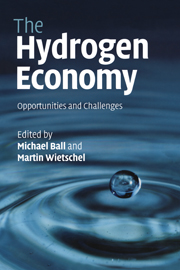Book contents
- Frontmatter
- Contents
- List of main contributors
- Preface
- Acknowledgements
- List of abbreviations
- 1 Scope of the book
- 2 Why hydrogen?
- 3 Non-renewable energy resources: fossil fuels – supply and future availability
- 4 Non-renewable energy resources: nuclear fuels
- 5 Assessment of the potentials for renewable energy sources
- 6 Carbon capture and storage
- 7 Energy-chain analysis of hydrogen and its competing alternative fuels for transport
- 8 Hydrogen today
- 9 Fundamental properties of hydrogen
- 10 Hydrogen production
- 11 Hydrogen storage
- 12 Hydrogen distribution
- 13 Key role of fuel cells
- 14 Hydrogen-infrastructure build-up in Europe
- 15 Building a hydrogen infrastructure in the USA
- 16 Hydrogen and the electricity sector
- 17 Hydrogen corridors
- 18 Macroeconomic impacts of hydrogen
- 19 Sustainable transport visions: the role of hydrogen and fuel-cell vehicle technologies
- 20 Energy-efficient solutions needed – paving the way for hydrogen
- 21 The future of hydrogen – opportunities and challenges
- Further reading
- Index
- References
15 - Building a hydrogen infrastructure in the USA
Published online by Cambridge University Press: 22 January 2010
- Frontmatter
- Contents
- List of main contributors
- Preface
- Acknowledgements
- List of abbreviations
- 1 Scope of the book
- 2 Why hydrogen?
- 3 Non-renewable energy resources: fossil fuels – supply and future availability
- 4 Non-renewable energy resources: nuclear fuels
- 5 Assessment of the potentials for renewable energy sources
- 6 Carbon capture and storage
- 7 Energy-chain analysis of hydrogen and its competing alternative fuels for transport
- 8 Hydrogen today
- 9 Fundamental properties of hydrogen
- 10 Hydrogen production
- 11 Hydrogen storage
- 12 Hydrogen distribution
- 13 Key role of fuel cells
- 14 Hydrogen-infrastructure build-up in Europe
- 15 Building a hydrogen infrastructure in the USA
- 16 Hydrogen and the electricity sector
- 17 Hydrogen corridors
- 18 Macroeconomic impacts of hydrogen
- 19 Sustainable transport visions: the role of hydrogen and fuel-cell vehicle technologies
- 20 Energy-efficient solutions needed – paving the way for hydrogen
- 21 The future of hydrogen – opportunities and challenges
- Further reading
- Index
- References
Summary
While the previous chapter addressed the build-up of a hydrogen infrastructure in Europe, this chapter focuses on implementing a hydrogen infrastructure in the USA, where, over the last decade, the vision of hydrogen as a future transportation fuel has gained remarkable momentum.
Introduction – transportation-energy context in the USA
A large part of primary energy use, greenhouse-gas emissions and air pollution in the United States comes from direct combustion of fuels for transportation and heating. Reducing emissions and energy use from this multitude of dispersed sources (250 million vehicles and perhaps 100 million households and businesses) will mean replacing today's cars and heating systems with higher efficiency, low-emission models, and, ultimately, adopting new fuels that can be produced cleanly and efficiently from diverse sources. This is particularly crucial for transportation, where the number of light-duty passenger vehicles could grow 50% by 2050, and where 97% of fuel comes from petroleum, 60% of which is imported into the United States.
A variety of alternative fuels, including LPG, CNG, ethanol, methanol, as well as electricity, have been implemented on a small scale in the USA, but with limited success – the total number of alternative fuelled vehicles remains less than 1% of the total fleet (Davis and Diegel, 2007). The largest alternative fuel used in the USA is ethanol derived from corn, which is currently blended with gasoline up to 10% by volume in some regions, and accounts for 3% of US transportation energy use.
- Type
- Chapter
- Information
- The Hydrogen EconomyOpportunities and Challenges, pp. 454 - 481Publisher: Cambridge University PressPrint publication year: 2009
References
- 2
- Cited by



